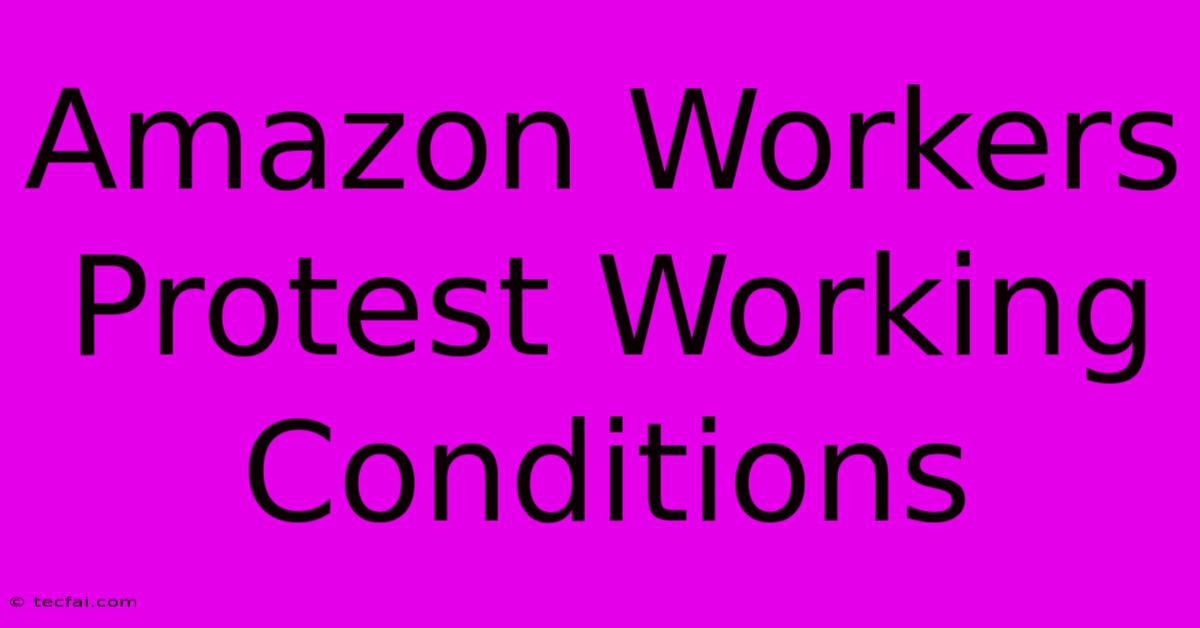Amazon Workers Protest Working Conditions

Discover more detailed and exciting information on our website. Click the link below to start your adventure: Visit Best Website tecfai.com. Don't miss out!
Table of Contents
Amazon Workers Protest Working Conditions: A Growing Movement
Amazon, the behemoth of e-commerce, faces increasing scrutiny regarding its working conditions. Across the globe, Amazon workers are staging protests, highlighting concerns about pay, safety, and overall treatment. This article delves into the key issues driving these protests and examines their potential impact on the company and the broader landscape of labor relations.
The Core Issues Fueling the Protests
Several key issues consistently emerge in protests across various Amazon facilities worldwide. These include:
1. Wages and Benefits: The Fight for a Living Wage
A central theme of many protests is the demand for higher wages and improved benefits. Workers often cite wages that are insufficient to meet the cost of living, especially in areas with high housing costs. Concerns also extend to the availability and adequacy of healthcare benefits, retirement plans, and paid time off. Protesters argue that Amazon, a company generating billions in profits, should better compensate its workforce.
2. Working Conditions: Safety and Well-being Concerns
Safety concerns frequently surface in worker protests. The physically demanding nature of warehouse work, coupled with intense pressure to meet productivity targets, leads to injuries and burnout. Reports of inadequate safety measures, insufficient breaks, and a lack of ergonomic support contribute to a climate of concern. Workers argue that the relentless pace of work prioritizes efficiency over the well-being of its employees.
3. Unionization Efforts: The Drive for Collective Bargaining
The desire for unionization is a powerful force behind many Amazon worker protests. Unions provide a collective voice for employees, enabling them to negotiate for better wages, benefits, and working conditions. Amazon's history of actively resisting unionization efforts has fueled worker discontent and intensified protests. The fight for union representation represents a broader struggle for worker rights and empowerment.
4. Technological Surveillance: Monitoring and Privacy Concerns
The use of technology to monitor worker performance is another contentious issue. Amazon's sophisticated tracking systems monitor productivity levels, raising concerns about employee privacy and the potential for unfair treatment. Protests often highlight the feeling of constant surveillance and the pressure this creates.
The Impact of the Protests
The ongoing protests have significant implications:
- Public Perception: Negative press surrounding worker protests can damage Amazon's public image, potentially impacting consumer loyalty.
- Operational Disruptions: Strikes and protests can disrupt operations, leading to delays in order fulfillment and potentially impacting the company's bottom line.
- Legislative Action: Increased awareness of worker issues can lead to greater regulatory scrutiny and potential legislative changes impacting labor practices.
- Shifting Labor Dynamics: The protests highlight a broader shift in labor relations, with workers increasingly demanding better treatment and challenging the dominance of large corporations.
The Future of Amazon Worker Protests
The future will likely witness continued protests and activism from Amazon workers. The issues raised are deeply rooted and unlikely to disappear quickly. The outcome of these struggles will significantly influence the future of labor relations in the gig economy and the broader tech industry. The success or failure of unionization efforts, along with legislative and public pressure, will play a pivotal role in shaping Amazon's employment practices and the treatment of its workforce. The fight for better working conditions at Amazon is a fight for fairer working conditions for all.

Thank you for visiting our website wich cover about Amazon Workers Protest Working Conditions. We hope the information provided has been useful to you. Feel free to contact us if you have any questions or need further assistance. See you next time and dont miss to bookmark.
Featured Posts
-
Tik Tok Trend Crowns Demure Word Of 2024
Nov 30, 2024
-
Galway Election Live Results Updates
Nov 30, 2024
-
Colorado Vs Oklahoma State Hunter Highlights
Nov 30, 2024
-
Hailee Josh Confirmed Engagement
Nov 30, 2024
-
Sick New World 2025 Cancellation News
Nov 30, 2024
